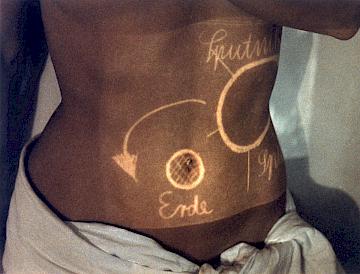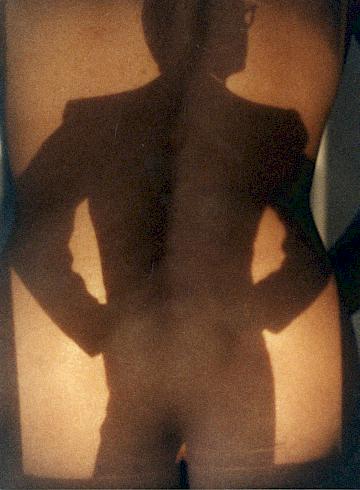Birgit Jürgenssen. Body Projection (The Magician Houdini)
What Birgit Jürgenssen projected onto parts of her naked skin in 1988, and documented in evanescent yet large-scale photographs are enigmatic signs of what is called mysterious femininity - sphinxes (ph966) , animal-like imagery (ph1732)
, animal-like imagery (ph1732) , astral signs (ph34)
, astral signs (ph34) , as well as the shadows of bodies (ph1730)
, as well as the shadows of bodies (ph1730) . Many of these photographs were used for the artist´s book I met a stranger (1996), which she designed together with Lawrence Weiner. The book elaborates on a drama of the gaze: pages of typography - "They looked at me (again)" - with framed cut-outs offer partial views of photographs of skin and body on the following page. The uncanny is the point of connection between the book and the projection entitled Houdini. Projected onto her abdomen in this coarse-grained color photograph is the almost indecipherable likeness of the famous magician and escape artist, who presents himself (with an expansive gesture) next to a saw as tall as himself, between the two halves of a woman ostensibly sawn in two. Something outrageous is happening here, something that is owed to deception and ought by no means to be ascribed to a supernatural realm. Jürgenssen´s body - her hips clothed in fabrics that, as it were, serve as a pedestal to a section of her body and to the image, in textiles reminiscent of 19th century French erotic representations of bathing - partakes in the staging of the gaze on a sexual object; her navel seems to be the eye (of a third party), an investigator´s gaze - situated precisely at the location of Houdini´s genitals. This navel can be read as the inverted image of an eye (gaze) in the place of a double lacuna: just as Jürgenssen´s abdomen seeks to close (as the material support of the image) the gap in the body of the woman split into two, it supplements Houdini´s legerdemain and the viewer´s gaze with the sign of a cannily furtive and vigilant observation, a counter-gaze.
. Many of these photographs were used for the artist´s book I met a stranger (1996), which she designed together with Lawrence Weiner. The book elaborates on a drama of the gaze: pages of typography - "They looked at me (again)" - with framed cut-outs offer partial views of photographs of skin and body on the following page. The uncanny is the point of connection between the book and the projection entitled Houdini. Projected onto her abdomen in this coarse-grained color photograph is the almost indecipherable likeness of the famous magician and escape artist, who presents himself (with an expansive gesture) next to a saw as tall as himself, between the two halves of a woman ostensibly sawn in two. Something outrageous is happening here, something that is owed to deception and ought by no means to be ascribed to a supernatural realm. Jürgenssen´s body - her hips clothed in fabrics that, as it were, serve as a pedestal to a section of her body and to the image, in textiles reminiscent of 19th century French erotic representations of bathing - partakes in the staging of the gaze on a sexual object; her navel seems to be the eye (of a third party), an investigator´s gaze - situated precisely at the location of Houdini´s genitals. This navel can be read as the inverted image of an eye (gaze) in the place of a double lacuna: just as Jürgenssen´s abdomen seeks to close (as the material support of the image) the gap in the body of the woman split into two, it supplements Houdini´s legerdemain and the viewer´s gaze with the sign of a cannily furtive and vigilant observation, a counter-gaze.